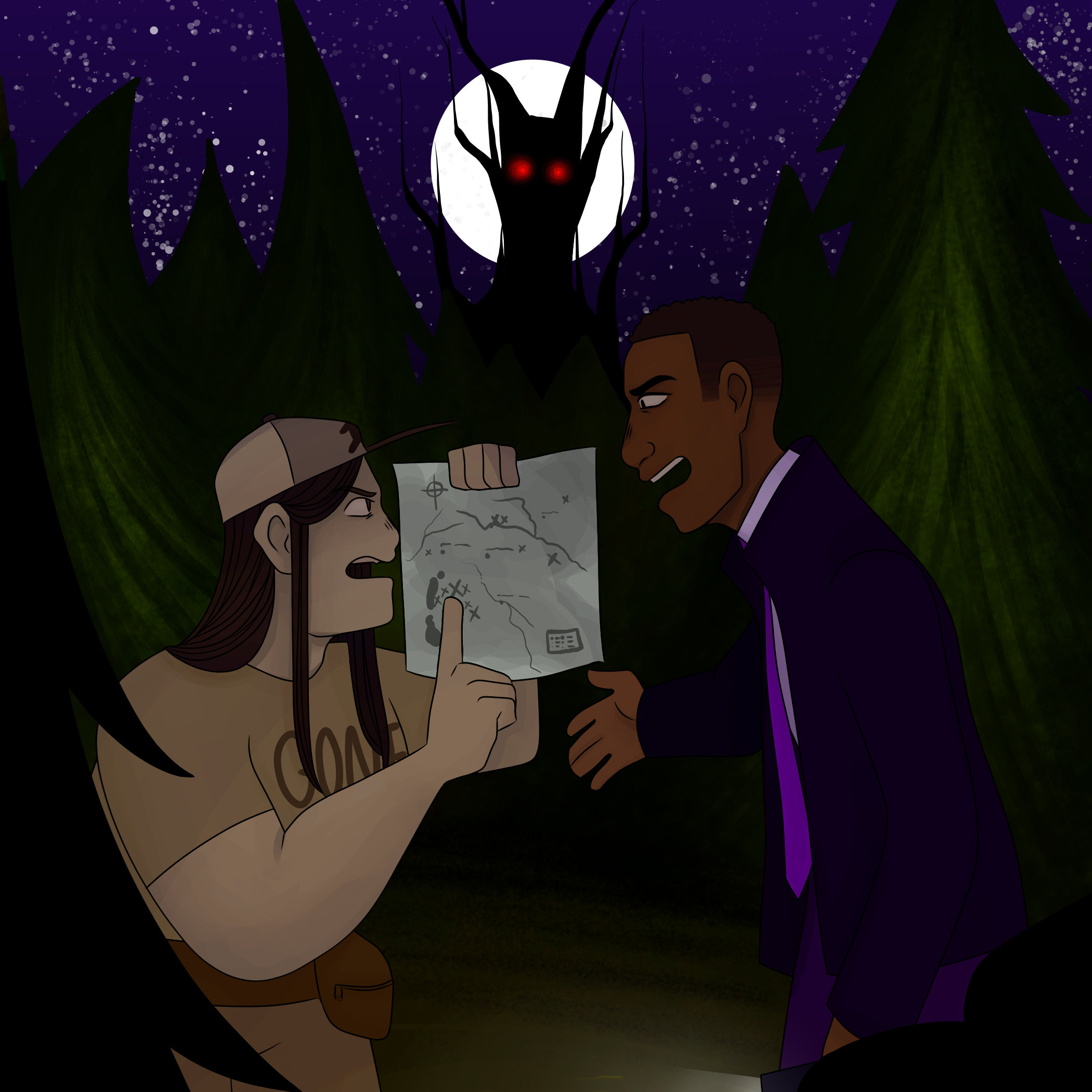Another is a game we spun up in a month for the #cryptidjam last year at itch, where participants built a game in a month’s time on the theme of cryptids. The Good That Zoos Do creates agents of a supernatural zoo as well as the monster they are hunting. The cryptid is revealed during a flashback scene where it interacts with a group of disposable NPCs and its traits are defined through the process of eliminating them. The rest of the session, play is between the players as agents and the GM as both setting and the cryptid itself with a playing card mechanic resolving all the actions. It is based largely on the Zoo Podcast and their ongoing series about monster hunters and occasionally empathetic intelligent cryptids.
Category: Uncategorized
Grin RPG (or How Do I Play Jenga Online)
Last week, I had the treat of sharing an rpg table with my college roommate for the first time. We have games together in other formats (our dining room table was never used for meals but permanently set for Necromunda), but this was the first time we played together. Normally I introduce first-time roleplayers with something straightforward (like Dread) or ridiculous (like Crash Pandas). I opted for straightforward and planned to run something out of the Harrop Collection but there’s the issue of how to do social distance right now within arm’s reach of a Jenga tower…
There are lots of options for running a game online. You have Discord servers, various video chat options, digital tables, and play-by-post. You could even dust off your typewriter and get started on a De Profundis campaign, but I’ve never had one make it more than two letters in, despite our best efforts [link]. But none of those do Jenga, and networked BoomBlox as a resolution mechanic feels cumbersome. Enter Grin.
more “Grin RPG (or How Do I Play Jenga Online)”Always/Never/Now
Earlier this week I had the opportunity to complete a run of Will Hindmarch’s Almost/Never/Now, a cyberpunk take on Lady Blackbird. It was inspired by revisiting a long-running cyberpunk campaign he had been a part of, and wrote the adventures that would become A/N/N as a sort of love letter/dramatic finale to the world and characters he and his friends had created and inhabited a decade prior.
The sessions themselves blend story, action, and character in a flexible form that encourages big storytelling: cinematic action, dramatic blow-outs with your peers, and always pushing what the mechanics allow. This is a collaborative story situation, writ large over international espionage and dystopian intrigue with cyberware and technology and highly specialized weaponry all coming to bear in a system that absolutely does not concern itself with the specifics of how you accomplish any of that.
more “Always/Never/Now”Far Space
Almost a year after my last big LARP experience (The Climb, played with basically the same group), we got together to try out a new project called Far Space by Christian Griffen. The print-on-demand website describes it thus:
This game is a Live Action Roleplay scenario based around escape-room-inspired problem solving challenges in which the fate of individual characters and the ship as a whole depends on the choices that the players make.
Far Space game description
I was immediately intrigued by the bridge simulator/ship in crisis vibe of the game. I’m a huge fan of any game that really wrestles with life aboard a vessel, be it a submarine, spaceship, or airship so I knew this was something I wanted to try. I’m also a fan of escape room-style puzzles and resource management, so that was a bonus when I found out what gameplay was going to be like.
more “Far Space”History, Lorebuilding, and Growing with Your Game
Most traditional rpgs* land somewhere along a line from “make it up as you go” to “pages of defined lore and backstory,” tending toward the latter in how the game runs at the table. For some groups, exploring the lore and its deeper implications and keeping up with the wider campaign world is part of the fun of the game. For players who have read the novels and GMs who have taken extensive notes on the people and places who will be turning up, that’s their brand of fun. If that’s you, I’m not necessarily talking to you right now. However, I think the following ideas might help you reach some of your fellow players who think of that kind of prep as something akin to homework.
The wider-world approach runs into some tight corners when it comes to character history and the fear of “getting it wrong.” Let’s say you want to play a Crane bushi who fought on the Wall as part of a diplomatic exchange between clans. (I know enough buzzwords to make a sentence. Take this for the example it is intended to be) Players with greater knowledge could object to what era that exchange is appropriate, whether or not it’s something that could happen, and the wider repercussions given the particulars of your game or setting. Similarly, the Emperor and Darth Vader potentially had some secret apprentices (especially under the old EU), one of whom might be unaccounted for in official settings for a PC or NPC backstory. But if everything grinds to a halt while Wookieepedia is consulted, then the plotline may be abandoned before anyone gets invested. But by trying to be thorough about background lore, you run the risk of eliminating every storyline that’s not already a part of the setting, leaving your players side characters in their own campaign as “canon” heroes sort out the big events.
As an alternative, consider a living history that can be revealed as you play. Summarize the important elements your campaign will make use of and get the campaign started from there. Feel free to bait some story hooks with existing lore to give your players a reason to get or stay invested in the published setting, but introduce elements when and how you can to invite a deeper study of the world. This way, it’s not homework front-loaded at the beginning of the campaign but an unfolding story with layers for everyone. Even the deep loredivers will appreciate getting to experience it firsthand, especially if you can sneak up on a Big Moment and place them in the thick of it.
Some ways to incorporate your expanding worldbuilding is to borrow cues from video games or other rpgs. For example, consider borrowing a page from the Assassin’s Creed series with the Villa Auditore: a homebase with room for incremental improvements, home to NPCs who can deliver new information, housing secrets (and possibly an entrance to some level-appropriate challenges). By getting your party to invest in the community, they put down some roots and shed some of their adventure capitalist/cut-throat opportunist tendencies. By staying in one place while they develop their home base, you can go deeper into that region’s specifics and tie those reveals to the history of their location, making the history of your world personal.
Another route to deepening connections is having equipment and background elements grow with your characters. The disposability of most equipment is fine, but what about the pieces you just can’t part with? Inigo Montoya is not about to ditch his father’s masterpiece just because he found a vorpal +2 rapier. What if these weapons have opportunities to “level up” with your party, at the same rate that new equipment would be bestowed upon them? Maybe the ritual to imbue the weapon with holy energy can only happen on a particular auspicious day, or the reagent that must be sacrificed in the process is plot-rare and difficult to produce. This lets you develop new information about original equipment (“Who knew that there was still ancestral magic bound up in [this item]?”) or learn more about the specific history and magic of treasured items and tie it in with your larger world. Players might jump at the opportunity to power a trusted weapon or spell focus up instead of tossing one of the few constants of their adventuring career in preference of the new shiny bauble. This approach shares DNA with Thread Items in Earthdawn, and is explored/adapted further in my Razors of the Demon Barber for D&D 5E.
These concrete elements can tie into character backstory, integrate into local and world history, and give what came before a way to influence what comes next. If there’s interest, we can discuss what these sorts of elements would look like with particular game systems, so comment here or take it to Twitter.
*For the purposes of these examples, I’m assuming a pre-written world along the lines of Forgotten Realms, Shadowrun, Legend of the Five Rings, or Battletech. In terms of worldbuilding and lore, there’s a wiki of existing content as opposed to player input.
CUT TO: Stealing the Language of Film for Tabletop Gaming
Roleplaying games are distributed in book format (until someone invents an all podcast-and-YouTube-video distribution method), and has as its reference points prominent literary progenitors: Lord of the Rings, Dune, Neuromancer, Starship Troopers. But just as common, we talk about games in terms of film tropes and our games draw from film and television: the Matrix, Firefly, Star Wars, and Star Trek. A lot of jokes and memes have been written lately about “what if X was an rpg campaign?” What if the reverse was true?
A Gaming Hippie Heads Back to the Dungeon
I go way back with Dungeons and Dragons. I started on the black box, DMed 2nd Edition AD&D long ago, have dreamt of running Ravenloft for nearly as long, upgraded to 3rd edition in high school, joined some friends in college for D20 Modern (hey, it was the Aughts. A game is a game, right?), and ended up in a 3.5 game for a while after college. I skipped 4th, and played 5 or 6 levels of a 5th Edition campaign on Roll20 a couple years ago (a great campaign and a character I miss). I have played or run most versions of D&D in the last 25ish years, and it all comes down to this: I’m not very good at it.
Don’t get me wrong: I’m all for the optimization community and their efforts to tweak, fix, or break the various editions of the game. I love the technical twists and turns of an inventive build as much as the next guy (honestly, probably a lot more than the next guy), and deeply appreciate the far end of it: the PunPuns and Peasant Railguns and Elven artificers who use a feedback loop of suffering to understand all things. It’s inventive and crazy and I am not the guy for it. I don’t play that way, and never played with a group that deemed it important enough for us all to rise to the occasion. As a result, the one player who rides that train does so alone and stands head and shoulders past the rest of us scrub rookies. I went down a different path a while ago. more “A Gaming Hippie Heads Back to the Dungeon”
Running on Empty: Tales from the Road (Ten Candles)
I’m working on a new project for the One-Shots which implements the Running on Empty setting as its background. Since Ten Candles happens in the dark, and Running on Empty is a survival horror setting where the sun never comes up, it made sense to me to figure out how they fit together.

